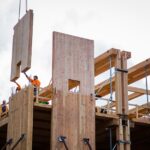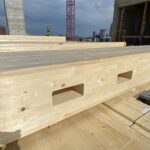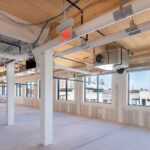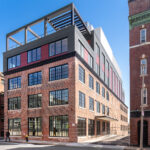Expert Tips
Construction Tolerances for Light Wood-Frame Projects
Covers commonly accepted guidelines for vertical in-plane wall tolerances, horizontal in-plane wall tolerances, and positional or layout tolerances.
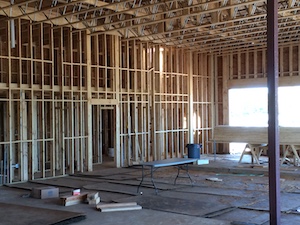
Construction tolerances are a means of controlling items such as vertical element plumb, size and/or length of structural members, and general layout and location. Regardless of the material being used for a building’s structural elements, tolerances are often controlled by product and finish manufacturers in order to ensure product performance. The tolerance guidelines listed below are typical of all light-frame construction and not necessarily specific just to wood framing.
Although there are no specific requirements for construction tolerances of light-frame wood construction in the International Building Code (IBC) or referenced standards such as the American Wood Council’s National Design Specification® (NDS®) for Wood Construction, the following are commonly accepted guidelines.
For vertical in-plane wall tolerances (i.e., plumb wall surfaces):
- The Residential Construction Performance Guidelines suggest a maximum out of plumb of 3/8″ in 32″ vertically, while the Handbook of Construction Tolerances suggests that this may need to be tightened to 1/4″ in 10ˈ when finishes such as gypsum wallboard and plaster are used.
- Similarly, the United Facilities Guide Specification (UFGS) suggests a tolerance of 1/4″ in 8ˈ for plumbness of studs when finishes such as wallboard, plaster or ceramic tile set in a mortar bed are used. For finishes such as ceramic set in dry-set mortar, latex-portland cement mortar, or organic adhesive, the UFGS suggests a plumb tolerance for walls of 1/8″ in 8ˈ.
- The Residential and Light Commercial Construction Standards suggest a tolerance limit of 1/4″ in 32″ vertically.
For horizontal in-plane wall tolerances (i.e., straight wall surfaces):
- The Handbook of Construction Tolerances suggests a maximum misalignment of 1/8″ for adjacent framing members when gypsum wallboard is being directly attached to them.
- The Residential Construction Performance Guidelines suggest a tolerance limit of 1/2″ in 32″ horizontally or 1/2″ in 8ˈ vertically for walls that have a bow.
- The UFGS suggests a limit of 1/4″ in 8ˈ for face of framing members from true plane when finishes such as wallboard, plaster or ceramic set in a mortar bed are used.
- In addition to these documents, many finish manufacturers and/or industries provide tolerance limitations for the framing members their finishes are being attached to. For example, the Gypsum Association states in GA 216 and ASTM C-840 that, when installing gypsum wallboard, “the attachment surfaces of any framing member shall not vary more than 1/8″ from the plane of faces of adjacent framing members.”
For positional or layout tolerances (i.e., location of elements):
- The Handbook of Construction Tolerance suggests +/- 1/4″ for light-frame construction and +/- 1/8″ for heavy timber construction.
- Echoing this, the UFGS suggests a 1/4″ tolerance limit for layout of walls and partitions, relative to intended location. The UFGS also recommends a 1/4″ in 8ˈ tolerance for straightness of plates and runners and true plane of framing when finishes such as wallboard, plaster or ceramic set in a mortar bed are used.
Several construction tolerance references are:
- The Residential Construction Performance Guidelines, National Association of Home Builders
- The United Facilities Guide Specification, Section 06 10 00: Rough Carpentry 3.4
- Handbook of Construction Tolerances, David Kent Ballast.
- Residential Construction Standards, National Association of State Contractors Licensing Agencies
- Residential and Light Commercial Construction Standards, RS Means
Although sometimes confused with construction tolerances, especially in permanently-loaded members such as floor joists or roof beams, baseline requirements for serviceability checks such as member deflection are addressed in the code. IBC Table 1604.3 lists minimum deflection criteria for both dead and live load conditions for a number of different structural members and types of finishes. However, as with construction tolerances, finish manufacturers or industries may publish more stringent deflection criteria. These limits, as well as any local or state codes, should always be checked when specifying deflection and construction tolerance limits in wood construction.
